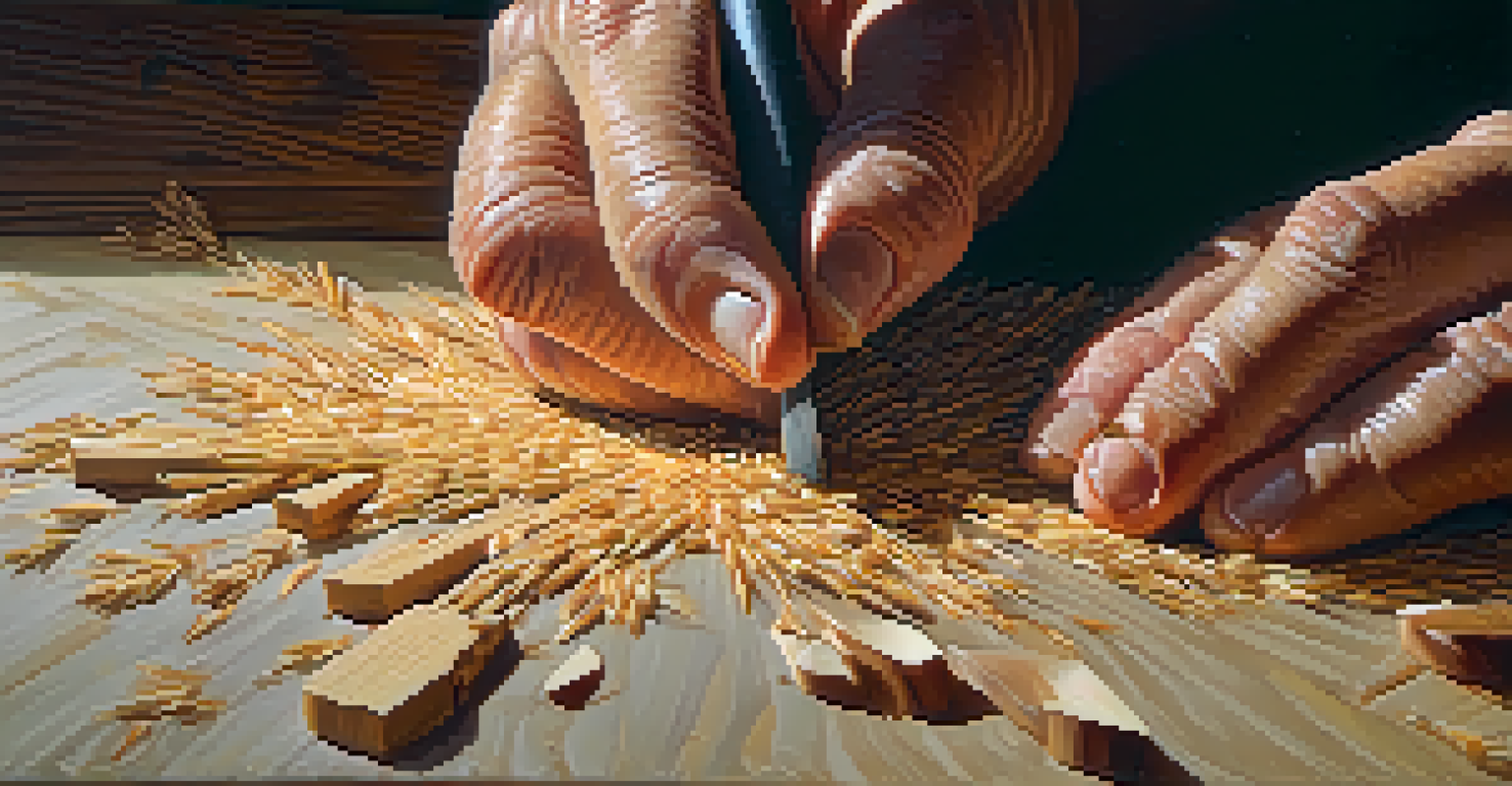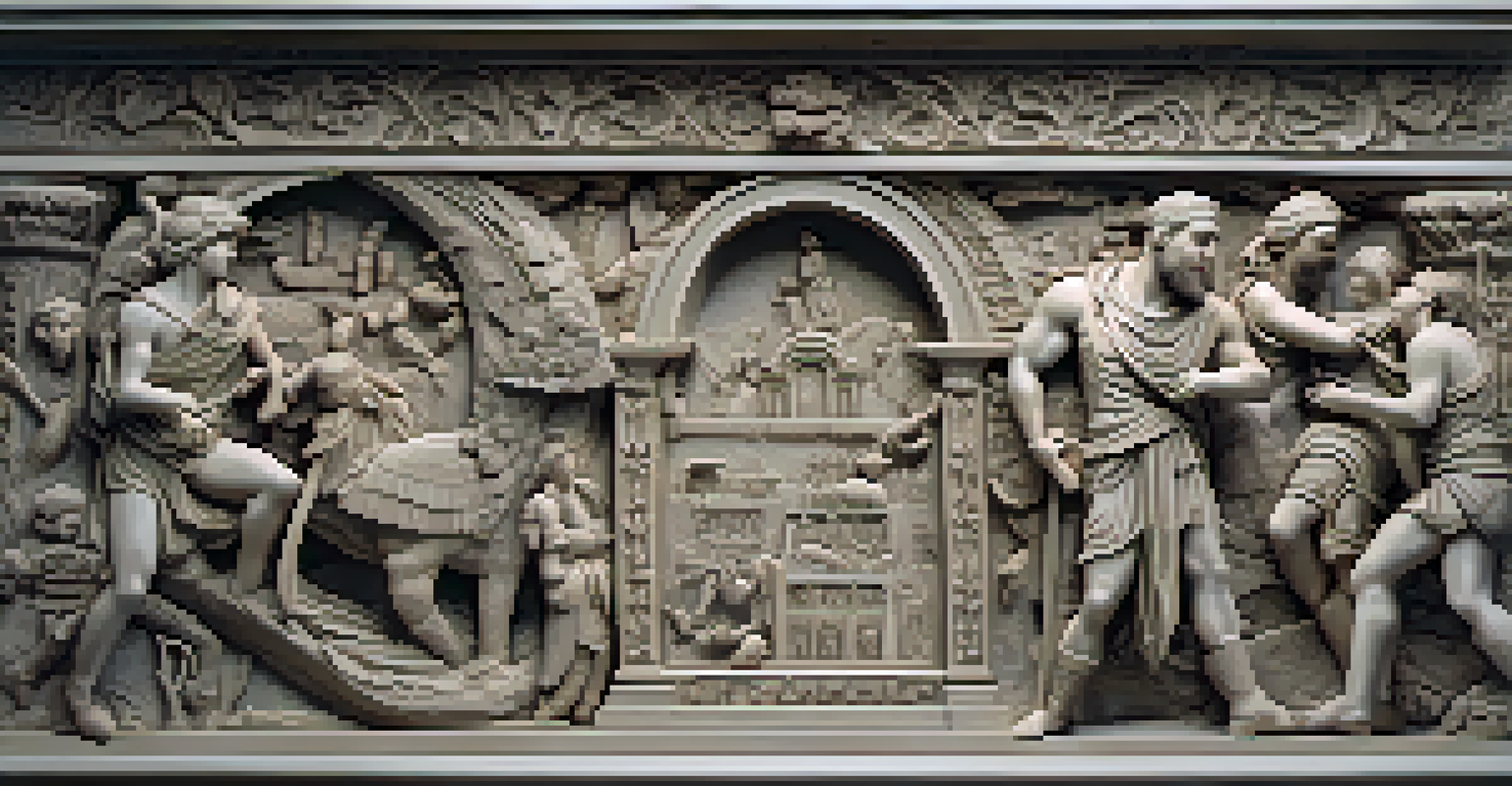Carving as Cultural Dialogue: Communicating Through Art

The Origins of Carving in Different Cultures
Carving has been an integral part of human expression for centuries, with roots that can be traced back to ancient civilizations. From the intricate stone carvings of the Egyptians to the delicate woodwork found in Asian cultures, each piece tells a story unique to its environment. This art form not only showcases craftsmanship but also reflects the values and beliefs of the society that created it, highlighting the deep connection between culture and art.
Art is a universal language that speaks to the soul, transcending cultural boundaries and fostering understanding.
As we explore various cultures, we find that carving is often used to communicate important messages, whether spiritual, historical, or social. For instance, Indigenous tribes in North America create totem poles that represent lineage and tribal stories, each carving symbolizing different aspects of their heritage. This demonstrates how carving serves as a visual language, allowing communities to share their narratives and preserve their histories.
In modern times, these traditional forms of carving continue to evolve, blending with contemporary themes and techniques. Artists are now embracing both traditional methods and modern tools to convey messages about identity, belonging, and social issues. This fusion of old and new not only keeps the art form alive but also makes it relevant in today’s multicultural dialogue.
Carving as a Means of Expression and Identity
At its core, carving is a powerful method of self-expression, allowing artists to communicate their identity and experiences. Each stroke of the chisel or knife can convey emotions that words sometimes fail to express. This personal touch makes every carved piece unique, reflecting the artist's individual journey and cultural background.

For many artists, carving becomes a way to reclaim their heritage and assert their identity in a rapidly changing world. By incorporating traditional motifs and techniques, they honor their ancestry while also making bold statements about contemporary issues. This interplay between tradition and modernity fosters a deeper understanding of cultural identity and challenges the notion of cultural appropriation.
Carving Reflects Cultural Identity
Carving serves as a powerful medium of self-expression, allowing artists to convey their experiences and cultural heritage through their work.
Moreover, as artists share their carved works with the world, they invite viewers to engage with their stories. This dialogue can spark conversations about shared experiences, cultural differences, and the universal themes that connect us all. Through this exchange, carving transcends mere aesthetics, becoming a bridge that fosters empathy and understanding among diverse audiences.
The Role of Carving in Spiritual Practices
Carving often plays a significant role in spiritual and religious practices, serving as a conduit between the earthly and the divine. Many cultures create carved images of deities or spiritual symbols, using these representations to connect with their beliefs. For instance, in Hindu culture, intricate carvings on temples depict various gods and goddesses, serving both as art and as a form of worship.
The act of carving is a reflection of our inner self, a tangible expression of our thoughts, emotions, and cultural heritage.
These spiritual carvings are not just decorative; they carry profound meanings and are often used in rituals and ceremonies. They become focal points for meditation, prayer, and reflection, allowing practitioners to engage with their spirituality on a deeper level. This highlights how art can facilitate a dialogue between individuals and their beliefs, reinforcing the importance of carving in cultural practices.
Additionally, the process of carving itself can be seen as a spiritual journey for the artist. Many find that the act of creating becomes a meditative practice, allowing them to explore their inner thoughts and emotions. This connection between the artist and their craft further enriches the cultural dialogue inherent in carving, as it embodies both personal and communal spiritual narratives.
Carving as a Tool for Social Commentary
In an age where art is often used as a platform for social change, carving has emerged as a compelling medium for commentary. Artists are increasingly using traditional techniques to address contemporary issues such as climate change, inequality, and cultural preservation. Through their work, they challenge audiences to rethink societal norms and consider the implications of their actions.
For example, some contemporary carvers create pieces that highlight environmental concerns, using sustainable materials and methods to draw attention to the impact of industrialization. These works not only showcase the beauty of carving but also serve as a call to action, urging viewers to reflect on their relationship with the environment. This demonstrates how carving can be a powerful vehicle for raising awareness about pressing social issues.
Carving as Spiritual Connection
Many cultures use carving in spiritual practices, creating representations that facilitate a connection between the earthly and the divine.
Moreover, by engaging with these topics, artists foster a dialogue that encourages collaboration and understanding among diverse communities. The conversations sparked by these pieces can lead to collective action and empowerment, illustrating how art can influence change. In this way, carving transcends its traditional role, becoming a vital part of the discourse surrounding social justice and activism.
The Global Influence of Carving Techniques
Carving techniques vary widely across cultures, each bringing its own unique perspective to the art form. From the bold, graphic styles of African masks to the delicate, intricate designs of Asian lacquerware, these techniques reflect cultural significance and artistic innovation. This diversity enriches the global art landscape, offering a myriad of forms and styles for audiences to explore.
As artists travel and share their knowledge, these techniques often blend, creating new hybrid forms that celebrate both tradition and modernity. This exchange not only enhances the skills of individual artists but also fosters a greater appreciation for the diverse cultural roots of carving. For instance, the fusion of Maori carving styles with contemporary design can lead to vibrant new expressions that resonate with both traditional and modern audiences.
This global influence is also evident in art exhibitions and collaborations, where carvers from different backgrounds come together to showcase their work. These events facilitate cross-cultural dialogue, allowing artists to learn from each other and celebrate their differences. In doing so, they highlight the unifying power of carving, reminding us that art can transcend borders and bring people together.
Preserving Heritage Through Carving
As globalization continues to shape our world, the preservation of cultural heritage becomes increasingly vital. Carving plays a key role in this effort, as it embodies the traditions, stories, and values of a community. By passing down carving techniques from generation to generation, cultures maintain a tangible connection to their roots.
Many communities are now actively working to revitalize traditional carving practices that may be at risk of fading away. Workshops, mentorship programs, and cultural festivals are just a few ways in which artisans share their knowledge and skills with younger generations. This not only helps to keep the craft alive but also instills a sense of pride and identity within the community.
Carving Promotes Social Awareness
Contemporary artists leverage carving to address social issues, using their craft to spark dialogues and inspire action for change.
Furthermore, the creation of public art installations featuring traditional carvings can serve as a reminder of cultural heritage in urban spaces. These pieces invite everyone to engage with the history and stories behind them, fostering respect and appreciation for the diversity of cultural expressions. In this way, carving becomes a powerful tool for cultural preservation, ensuring that future generations can continue to engage in this rich dialogue.
The Future of Carving as a Cultural Dialogue
Looking ahead, the future of carving as a medium for cultural dialogue is filled with potential. As artists continue to experiment with new materials, technologies, and themes, the possibilities for expression are virtually limitless. This evolution encourages a dynamic conversation about identity, culture, and the role of art in society.
Additionally, the rise of digital platforms allows artists to showcase their work to a global audience, fostering connections that transcend geographical boundaries. Virtual exhibitions, social media, and online galleries provide spaces for carved art to reach those who may not have access to traditional galleries. This democratization of art opens the door for diverse voices and perspectives to be heard.

Ultimately, carving will continue to serve as a vital form of communication, reflecting the ever-changing cultural landscape. By embracing innovation while honoring tradition, artists can ensure that carving remains a relevant and impactful medium for dialogue in the years to come. This ongoing conversation not only enriches our understanding of art but also highlights the shared human experiences that unite us all.